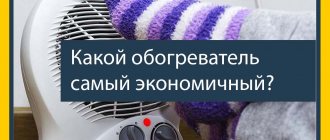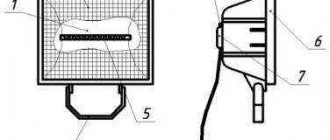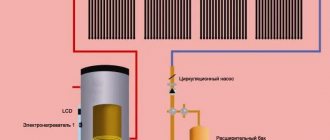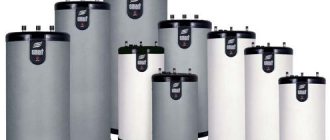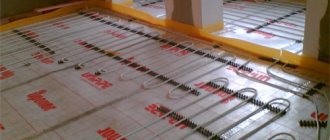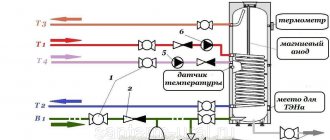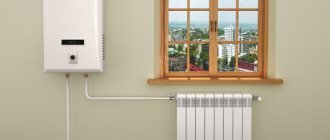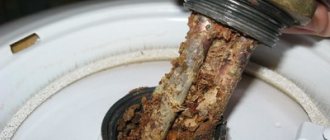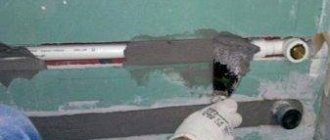The tubular electric heater - heating element was invented in the middle of the 19th century; over the 158 years of its existence, it has become an indispensable element of many household appliances associated with active heating of water. The heating element for a water heater is the main part - without it, normal operation of washing machines and dishwashers is impossible, not a single electric boiler will be able to heat water in the absence of this component.
Purpose and type
For any water heating product, heating elements are the main part. They operate from the electrical network, so designers use them when developing various electric heating devices, from a regular kettle to large-capacity automated boilers.
The heating element for a water heater is structurally a hermetically sealed copper tube with a nichrome spiral inside, which is usually located in the lower part of the product or, in exceptional cases, on the side. The lower location is more acceptable because it ensures uniform heating of the entire volume of water.
Depending on the design, heaters are divided into “dry” and “wet”. The first are so called because they do not have contact with water - their body is hidden by a hermetic flask. Water heaters with dry heating elements are used for modern models. Manufacturers consider this design to be more durable, since the body of the heating element is not constantly exposed to water - the absence of lime deposits and scale significantly extends the life of the heating element. They will not burn out if the user accidentally turns on the boiler without water.
Dry heating element
However, the most common model is considered to be wet or submerged heating elements. Some users believe that this is already an outdated model and is completely in vain - they continue to be used everywhere in various water heaters. The main disadvantage of such a heater is considered to be the tendency to frequent breakdowns due to scale and deposits, but compared to their dry counterpart, they are easier to find on sale, easier to replace and, naturally, they are cheaper.
Wet heating element
Heating element design
A nichrome heating coil is placed inside a metal tube, the material of which is selected taking into account the heated medium. The size and cross-section of the nichrome resistance wire for the heating coil is carefully selected and checked by special calculations to ensure the longest possible service life. Then the heating coil of the heating element is welded to the contact pin and insulated with sealant. Inside the tube, between the spiral and the shell, an insulator is placed, which is high-quality magnesium oxide, which is tightly compressed around the heating element and easily conducts heat.
Design Features
The standard design of a wet heater consists of the following elements:
- hollow copper or stainless steel tubes bent in different ways;
- inside there is a spiral of nichrome thread;
- The insulator is a heat-conducting substance - quartz sand or magnesium oxide.
A dry or closed heating element for a boiler is distinguished by the presence of an insulating flask made of high-strength ceramic. Sometimes its body is made of magnesium silicate or inorganic steatite, but not of metal. Heating occurs through this protective flask, and the tubular element itself does not come into contact with the aqueous environment, and therefore lasts a long time.
If we are discussing which types of heating elements are better, then we should immediately note that there are very significant differences in power and configuration - for wet elements there are differences in the fastening used, bending shapes and materials for making the housing. The type of tank used in the boiler determines the shape of the heater - according to this characteristic, the electric heater can be made straight or bent in different directions. In the main body, wet heating elements are made of copper and stainless steel. A dry heating element for installation in a boiler is made in the form of a straight rod of different lengths and diameters - this depends on the volume of the tank, the body is made of stainless steel, and the soapstone coating is made specifically for each model.
Features and advantages of heating elements Polymer heating
- Custom formed to suit specific requirements
- Shells available in stainless steel, carbon steel or copper
- Excellent heat transfer
- Various tube diameters and lengths available
- Quality assurance
- Directly from the manufacturer in Russia
Elements can be supplied with threaded connections for mounting through the walls of tanks, ovens, etc. Compression threaded connections are also available for easy on-site installation. Rings, clamps, brackets and washers can also be attached to elements for mounting purposes.
Difficult choice
When purchasing a water heater, users naturally face the question of what type of heating element will be best for the boiler. To do this, you must, at a minimum, become familiar with their performance characteristics.
The standard installation of all heaters in products is of the flange type. In this way, full contact with the heated liquid is achieved, but during operation deposits and corrosion products appear on the body, which significantly slow down the heat transfer effect.
The heating process increases over time, which leads to increased energy consumption. Designers from different manufacturers use various modifications that slow down the formation of deposits and scale, but wet heating elements tend to quickly fail, and their maintenance is quite complicated.
Dry heaters have a longer service life due to the fact that their body almost never comes into contact with the heated water. The inside of the tank, as well as the heater mounting flanges, are coated with special enamels based on titanium or glass porcelain - such corrosion protection prevents the occurrence of deposits and scale.
During long-term operation, wet-type thermal heaters become overgrown with scale, which can lead to breakdown and the user will receive an electric shock through the body of the product. In the dry version, this negative possibility is eliminated, because a ceramic bulb, which is a dielectric, is installed between the liquid and the heater body. In addition, this option completely eliminates overheating of the heater housing, service maintenance is reduced to a minimum, but periodic replacement is not excluded, although many times less often.
Many manufacturers have launched the production of large-capacity water heaters using two types of heating elements at once, which contributes to high reliability and increased service life.
Statistics confirm that closed heating elements last three times longer than their open counterparts - wet ones last no more than 5 years, and dry ones no less than 15 years. The cost of open heaters is much lower, they are more practical for repairs, but if you do not plan to maintain your water heater, then it is better to opt for the dry option.
What kind of heaters are produced?
Different models of water heaters differ in heating devices, so you need to know their features in order to choose an identical heating element for your boiler.
Ariston
The famous concern from sunny Italy prefers heaters made of stainless steel with a chromium-nickel composition, but with a copper shell. The flange is made of brass - this helps to increase the thermal power of at least 1.5 kW. Heating elements of this design are used in all water heaters, both small-capacity types and volumes designed for hundreds of liters. The cost of a new similar element is in the range of 1.5-2.0 thousand rubles.
Thermex
Another Italian company supplies its products with two types of heaters at once, which significantly reduces the time for heating water - one with a power of 1 kW, and the other with a power of 1.5 kW. They work together or separately, which allows the user to adjust the heating process at their discretion. The body is made of an alloy for which there is a registered patent; the composition is kept secret. A big plus is that instead of them you can install heating elements from other manufacturers, for example, Atlantic or Garanterm.
Combustion
The Slovenian company uses tubular-type heaters, but covered with a glass-like glaze or glass porcelain protection, similar to the enamel that covers the inside of the container. In this way, developers successfully combat the appearance of scale and limescale, which leads to frequent breakdowns of this part. The water heats up to an optimal temperature of 900C, so when replacing or installing a heater from another manufacturer, the user must reduce it to 60 degrees so that the heater does not burn out.
Problems that occur
Here is a short list of common malfunctions in the operation of heating elements.
- When cold water runs out of the tap, this is a signal that there has been a violation in the connection between the heating element and the thermostat.
- If the product turns on and then turns off, this is the first signal that a rather thick scale or layer of limescale has formed on the heater.
- When, during self-installation, the user made various mistakes due to inexperience, a very impressive air cushion may appear in the container, which prevents the heating element from heating the water.
It is much easier to prevent any malfunction than to fix it later, with some effort and financial investment.
Replacement algorithm
Replacing a heating element in a water heater is a very labor-intensive operation and is carried out strictly according to certain regulations:
- disconnect the product from the electrical network;
- drain the water completely;
- remove the water heater from its mounts and turn it over for ease of carrying out all work;
- Unscrew the fastening of the bottom panel, photograph the location and order of wiring;
- disconnect the wires from the heating element and remove it from the tank body;
- clean the plaque and scale; if no damage to the housing is found, then install the heating element in place;
- in case of replacement, install a new heating element and reassemble in the reverse order.
Especially for inexperienced users, to help them carry out this operation correctly, there is a video where an experienced technician replaces the heating element in a boiler:
Types of tubular heaters from Polymernagrev
- Air tube heaters of any shape are made to order from heat-resistant carbon or stainless steel. They are used in stoves, household heating electrical appliances, drying chambers, saunas.
- Heating elements with fins are used to increase the heat transfer surface, resulting in higher temperatures and more efficient heating of the air.
- Water heating elements for various liquid media and oils can be made of almost any bend shape from metal tubes (copper, stainless steel or carbon steel).
- More powerful blocks of heating elements contain in their design single double-ended heating elements connected to a flange. At the Polimernagrev company you can order the production of heating elements blocks of non-standard shape according to your sample.
to buy air or water heating elements in the Polimernagrev store; to do this, you only need to contact our specialists by phone in Moscow located on the contact page or describe what you need in the order form on the website. Upon receipt of an application from the site, we will call you back to clarify the details, calculate the parameters and cost and tell you the price of the heating element and its production time.
